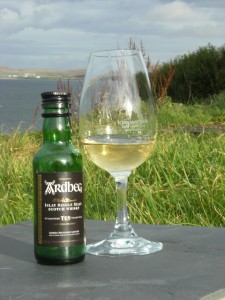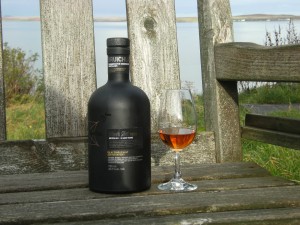Two Drams
Two Drams ~ Bruichladdich Black Art 3 and Ardbeg 10 year old.
What makes a good dram? Is this a different question than what makes a dram good for you? Yes, I think it is.
We can talk about whisky the way we talk about art. There is good art and bad art, and there is art you like ~ if you happen to like good art then you can feel very smug.
It can be the same with whisky. There are good drams and bad drams and there are drams you like (the smugness adage applies..)
There are many debates over the criteria we use to evaluate what constitutes good art. But I haven’t heard many discussions about the criteria we use to evaluate a good dram.
We take the criteria we use to evaluate a good dram for granted. We say this is a good dram, that is a good dram. We discuss the dram. But we have already implicitly agreed on what are good elements. We don’t often discuss how we decided on our premise.
We say that a good dram must be balanced, I agree. However, we tend to perceive of balance in predominately one way: as an unfolding of notes and tastes through a duration in time.
A good dram is usually perceived as a finely tuned intellectual chess game of a dram. It is conceived of as a journey where the dram unfolds like a musical score, with layers and repetitions, and agreeable harmonising of tastes and notes in a controlled, timely way. A dram like the SMWS Audrey Hepburn in a ball gown.
A dram like Ardbeg 10 years old.
I agree with this.
However, should good balance be perceived only as a controlled unfolding in length over time? Why cant balance be given status and value in another continuum?
If we take it for granted that our perception of the structure of a good dram is like the above, then we automatically assume that a whisky not fulfilling this criterion is less good ~ it becomes, by default, a bad whisky.
It is a question of thinking differently, ~ for example, most people say that the opposite of LOVE is HATE, but others, due to their perception of things, say that the opposite of LOVE is INDIFFERENCE.
Who is to say which perception is superior, and when is authority bestowed upon one’s assumption that their way is the best?
The point of all this assuming and loving or hating, is to make a case in point with the whiskies of Bruichladdich Black Art and Ardbeg 10-year-old.
By looking at things in a different way, the balance of Black Art can be seen to be equivalent to that of Ardbeg 10 year old.
The huge nose and taste of Black Art creates such an enormous sensation that if carried on for a long time could be too much, too over whelming. Drinking this is like diving naked off the high board into a swimming pool of velvet. One has a great initial sensate experience. One is engulfed in sensation.
The Ardbeg is not like that. The Ardbeg is a beautifully controlled journey, with the sensations unfolding harmonically through time.
But who can say which experience is superior? In one expression the experience unfolds through time, in the other, the experience occurs all at once.
The point is that both drams can be seen as well balanced ~ for what is given. The Black Art gives the 100% all in one go, the Ardbeg rolls it out a % at a time.
The balance is inherent in the EVENT of the drink. You cant have a one hundred per cent experience going on for a few seconds otherwise it wouldn’t be 100%.
In Black Art we experience 360 degrees of sensation immediately. In Ardbeg 10 years old, we experience the 360 degrees as a linear journey.
Do we only regard a dram as good if it fulfils a defined structure? When and who elevated the specific architecture of one dram over another?
Drinking whisky is about the pleasure of the experience. When did we decide that pleasure drunk in one way is superior to that of pleasure drunk in another?
This does not mean that all drams are created equal ~ they are not, some are very good and some can be bad.
But thinking about the structure of a dram and one’s unacknowledged assumptions is certainly a good point for discussion when next partaking of the water of life!
Slainte!


